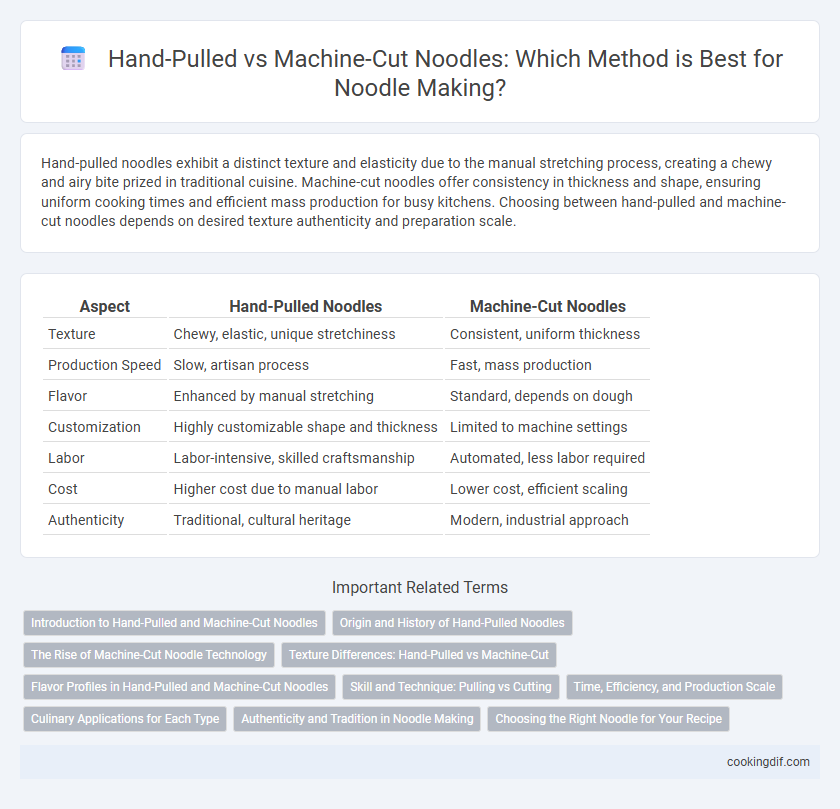Hand-pulled noodles exhibit a distinct texture and elasticity due to the manual stretching process, creating a chewy and airy bite prized in traditional cuisine. Machine-cut noodles offer consistency in thickness and shape, ensuring uniform cooking times and efficient mass production for busy kitchens. Choosing between hand-pulled and machine-cut noodles depends on desired texture authenticity and preparation scale.
Table of Comparison
| Aspect | Hand-Pulled Noodles | Machine-Cut Noodles |
|---|---|---|
| Texture | Chewy, elastic, unique stretchiness | Consistent, uniform thickness |
| Production Speed | Slow, artisan process | Fast, mass production |
| Flavor | Enhanced by manual stretching | Standard, depends on dough |
| Customization | Highly customizable shape and thickness | Limited to machine settings |
| Labor | Labor-intensive, skilled craftsmanship | Automated, less labor required |
| Cost | Higher cost due to manual labor | Lower cost, efficient scaling |
| Authenticity | Traditional, cultural heritage | Modern, industrial approach |
Introduction to Hand-Pulled and Machine-Cut Noodles
Hand-pulled noodles are crafted by repeatedly stretching and folding dough by hand, resulting in a chewy texture and irregular thickness that enhances sauce absorption. Machine-cut noodles are produced by rolling and slicing dough with precise, automated equipment, ensuring consistent shape and faster production. Both methods influence the noodle's texture, cooking time, and culinary applications, catering to diverse taste preferences and production scales.
Origin and History of Hand-Pulled Noodles
Hand-pulled noodles, originating from China over 4,000 years ago during the Western Han Dynasty, exemplify traditional craftsmanship where dough is stretched and folded repeatedly to create thin, elastic strands. This ancient technique reflects a rich cultural heritage linked to regions like Shaanxi and Lanzhou, known for iconic dishes such as Lanzhou beef noodles. Unlike machine-cut noodles, hand-pulled versions emphasize texture and elasticity achieved through skilled manual manipulation rather than mechanical slicing, preserving historical authenticity and culinary artistry.
The Rise of Machine-Cut Noodle Technology
Machine-cut noodle technology has revolutionized noodle production by significantly increasing efficiency and consistency compared to traditional hand-pulled methods. Automated cutting ensures uniform noodle thickness and length, which enhances cooking performance and texture in mass production. Advanced machine-cut systems integrate precision controls and high-speed processing, meeting the growing global demand for quick, reliable noodle manufacturing.
Texture Differences: Hand-Pulled vs Machine-Cut
Hand-pulled noodles exhibit a unique elasticity and chewiness due to the stretching process that aligns gluten strands, creating a distinctive texture favored in traditional Asian cuisine. Machine-cut noodles often have a uniform thickness and a smoother surface but lack the irregularities that contribute to the tactile experience of hand-pulled varieties. The texture differences impact mouthfeel and sauce absorption, with hand-pulled noodles providing a more artisanal bite compared to the consistent but less textured machine-cut noodles.
Flavor Profiles in Hand-Pulled and Machine-Cut Noodles
Hand-pulled noodles develop a distinct chewy texture and complex flavor due to the dough's extended gluten alignment during the pulling process. Machine-cut noodles offer uniform thickness and a consistent texture, which results in a milder, more neutral flavor profile. The artisanal stretching in hand-pulled varieties enhances the absorption of broths and sauces, intensifying overall taste compared to the precision-cut but less textured machine-cut noodles.
Skill and Technique: Pulling vs Cutting
Hand-pulled noodles require intricate skill and precise technique, as the dough is stretched repeatedly by hand to create thin, uniform strands, showcasing the noodle maker's craftsmanship and control over elasticity. Machine-cut noodles rely on mechanical blades to slice dough sheets into consistent widths, emphasizing efficiency and uniformity over the artisanal finesse found in hand-pulling. The difference in texture and chewiness largely stems from the stretching process in hand-pulling, compared to the slicing technique in machine-cut noodles.
Time, Efficiency, and Production Scale
Hand-pulled noodles require significant skill and time, allowing for artisanal quality but limiting production scale due to slower output. Machine-cut noodles increase efficiency, enabling mass production with consistent shape and size, drastically reducing preparation time. Industrial-scale factories favor machine-cut methods to meet high demand, while smaller establishments might prefer hand-pulled techniques for freshness and texture.
Culinary Applications for Each Type
Hand-pulled noodles offer a unique texture and chewiness prized in traditional Chinese dishes like Lanzhou beef noodle soup, where their elasticity enhances broth absorption and mouthfeel. Machine-cut noodles provide consistent thickness and shape, making them ideal for mass production in recipes requiring uniform cooking times such as Italian pasta or ramen. Chefs select hand-pulled noodles for artisanal culinary experiences, while machine-cut noodles suit fast-paced kitchens demanding efficiency and standardization.
Authenticity and Tradition in Noodle Making
Hand-pulled noodles embody the essence of authentic noodle making, showcasing traditional skills passed down through generations, characterized by their unique texture and elasticity achieved through manual stretching. Machine-cut noodles offer consistency and efficiency but often lack the artisanal qualities and nuanced variations that hand-pulling delivers, which are central to authentic culinary experiences. Emphasizing traditional hand-pulled methods preserves cultural heritage and the sensory richness integral to genuine noodle craftsmanship.
Choosing the Right Noodle for Your Recipe
Hand-pulled noodles offer a chewy texture and irregular thickness, ideal for hearty broths and rustic dishes that benefit from a more artisanal bite. Machine-cut noodles provide uniformity and consistency, making them perfect for quick-cooking soups and stir-fries where even cooking is essential. Selecting the right noodle depends on the desired texture, cooking time, and the overall flavor profile of your recipe.
Hand-pulled vs machine-cut for noodle making Infographic

 cookingdif.com
cookingdif.com